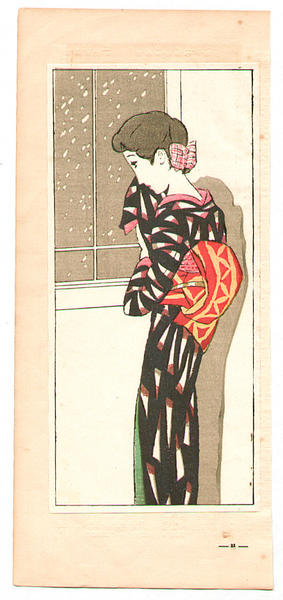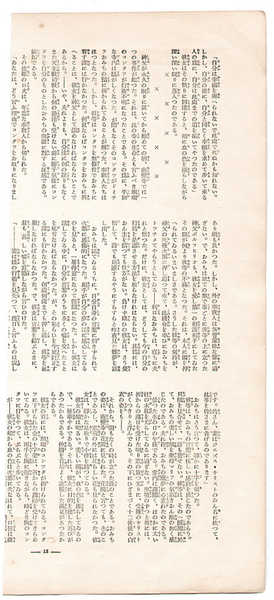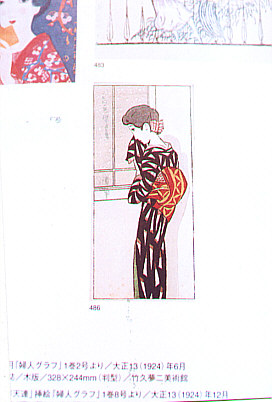| | |
| Artist: | Takehisa Yumeji (1884-1934) — 竹久夢二 |
| Title: | Looking at Falling Snow |
| Series: | |
| Date of first edition?: | Not set |
| Publisher (first edition)?: | Not Set |
| Publisher (this edition)?: | Not Set |
| Medium (first edition): | Woodblock |
| Medium (this edition): | Woodblock |
| Format (first edition): | Ko-tanzaku
|
| Format (this edition): | Ko-tanzaku |
| DB artwork code: | 39902 |
| Notes (first edition)?: |
|
| Notes (this edition)?: |
| The following information was taken from the original web listing of this artwork. Note that there may be some inaccuracies:
Title Looking at Falling Snow
rare, pre-W.W.II
Artist Yumeji Takehisa 1884-1934
Dated 1924
Publisher Kokusaijoho-sha
Medium/Technique Woodblock print
Impression good
Colors excellent - very good
Condition excellent - very good … slightly soiled on the background, the right edge pasted on the original book page (pg.12, the back of the page on which the print was pasted, is posted with the print image side by side).
Description A woodblock print pasted on a page of the novel, "Nanban-ji Byakuren" (White Lotus at Nanban Temple) published on the popular women's magazine, "Fujin Gurafu" in June, 1924. This design is in the permanent collection of "Takehisa Yumeji Art Museum" and was shown in the "Yumeji Exhibition" held by Machida Municipal Print Museum in 2001.
Note The medium-large image on the right shows this design displayed in the catalogue "Yumeji Exhibition" by the Machida Museum.
Width Item 4.7 inches = 12.0 cm
Height Item 9.8 inches = 25.0 cm
Width Mat 5.7 inches = 14.5 cm
Height Mat 12.8 inches = 32.5 cm |
|
| Artist Bio: |
Takehisa Yumeji (1884-1934) was a leading figure in the Taisho Romanticism movement that combined Western romanticism with native Japanese styles during the Taisho Period (1912-1926). He was a painter, writer, poet, bookbinder and illustrator whose drawings of women with thin bodies and large eyes filled with melancholy were known as Yumeji Bijin-ga. During the height of his popularity he was called the “modern Utamaro” and the Japanese “Toulouse-Lautrec and Edvard Munch”. His prints epitomized the relationship between popular art and the woodblock.
|
|




